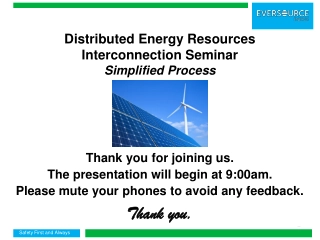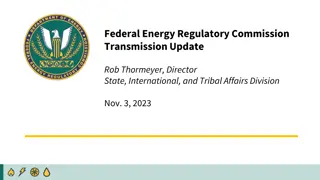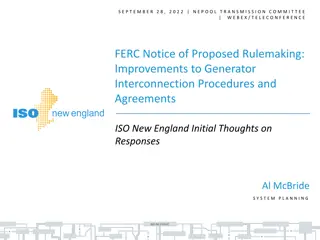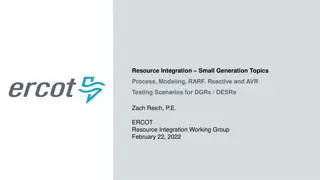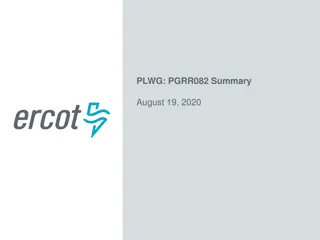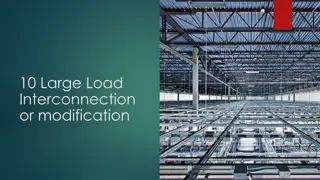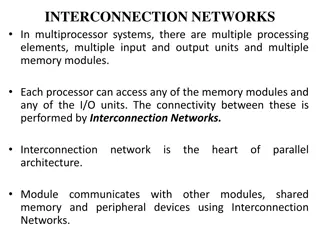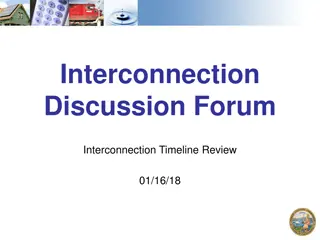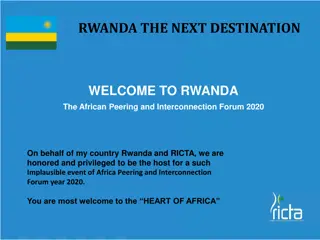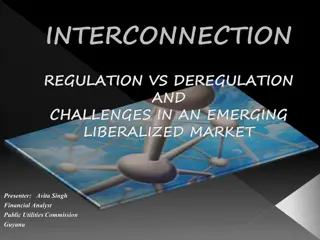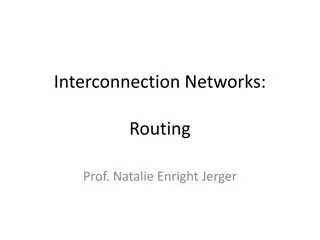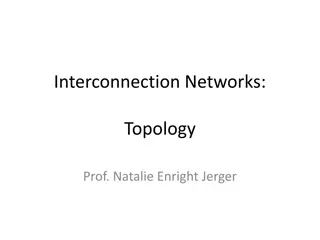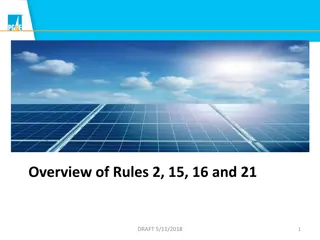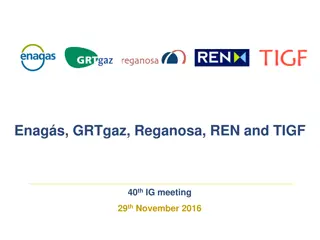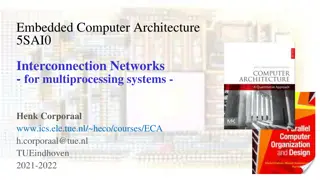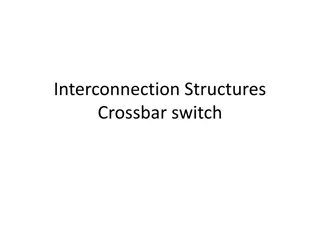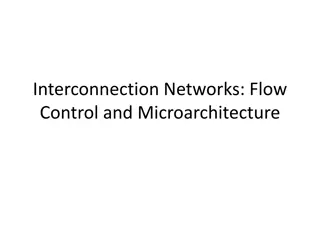DGR Interconnection Conditions Overview
Interconnection requirements for Distributed Generation Resources (DGR) include coordination with Distribution Service Providers (DSP), confirmation of operational limitations, and compliance with ERCOT regulations. These conditions ensure safe and efficient integration of DGRs into the electrical grid.
Download Presentation

Please find below an Image/Link to download the presentation.
The content on the website is provided AS IS for your information and personal use only. It may not be sold, licensed, or shared on other websites without obtaining consent from the author.If you encounter any issues during the download, it is possible that the publisher has removed the file from their server.
You are allowed to download the files provided on this website for personal or commercial use, subject to the condition that they are used lawfully. All files are the property of their respective owners.
The content on the website is provided AS IS for your information and personal use only. It may not be sold, licensed, or shared on other websites without obtaining consent from the author.
E N D
Presentation Transcript
Distribution Generation Distribution Generation Resource (DGR) Workshop Resource (DGR) Workshop Bill Blevins Director, Grid Operations November 5, 2019
DGR Conditions Document 1. As a condition for interconnection, Resource Entity must provide written confirmation from DSP stating that DSP has conducted appropriate studies to (i) confirm that DSP s system will not preclude the DGR s compliance with ERCOT s requirements concerning voltage ride-through, under-frequency and over-frequency relaying, and primary frequency response, and (ii) identify any limitations on the DGR s minimum or maximum MW output levels, charging levels (if applicable), or on the DGR s ramp rate that may be necessary due to DSP system limitations. If requested by ERCOT, Resource Entity has provided any requested DSP studies to ERCOT and any operational concerns have been addressed to ERCOT s satisfaction. Nodal Protocol Revision Request (NPRR), Planning Guide Revision Request (PGRR) As a condition for interconnection, Resource Entity must coordinate with DSP and the Transmission Service Provider that interconnects with DSP s system (hereinafter, TSP ) to ensure the electrical path from the DGR to the Resource Node has been modeled in a simplified manner (i.e., using an equivalent model) to ERCOT s satisfaction. As a condition for continued operation, Resource Entity must ensure this model information is updated to ERCOT s satisfaction as it changes from time to time. NPRR, PGRR 2. 2
DGR Conditions Document (cont) 3. As a condition for interconnection, Resource Entity must provide written confirmation from DSP that DSP has disclosed to Resource Entity all known distribution system operational limitations impacting the DGR s operation, including DSP-imposed limits on the rate or magnitude of injection or withdrawal, if any, and Resource Entity has confirmed to DSP and ERCOT that any such limitations are reflected in the ERCOT model, the DGR s Resource registration information, and/or in the DGR s real-time telemetry. As a condition for continued operation of the DGR, Resource Entity must ensure that any such limitations continue to be reflected in the ERCOT model, the DGR s Resource registration information, and/or in the DGR s real-time telemetry. NPRR, PGRR 4. As a condition for interconnection, if interconnecting to facilities owned by any DSP other than an MOU or EC, Resource Entity must provide ERCOT evidence of a written agreement with DSP pursuant to PUC Substantive Rule 25.212(a)(4) that the frequency relaying requirements in ERCOT rules, including Nodal Operating Guide Section 2.6.2, control in the event of any conflict with PUC Substantive Rule 25.212(c)(3). As a condition for continued operation, this agreement must remain effective, or some other agreement establishing these responsibilities must be in effect. NPRR 3
DGR Conditions Document (cont) 5. As a condition for interconnection, Resource Entity must provide ERCOT with written confirmation from DSP that the DGR is not connected to any line that is subject to manual or automatic disconnection by DSP or any Transmission or Distribution Service Provider or Transmission Operator as part of any Under-Frequency Load Shed, Under-Voltage Load Shed, or manual Load Shed scheme. As a condition for continued operation of the DGR, DSP must refrain from connecting the DGR to any such line. NPRR 6. As a condition for interconnection, Resource Entity must provide evidence of a written agreement with DSP reflecting a commitment by DSP to promptly notify Resource Entity or its Qualified Scheduling Entity ( QSE ) of any planned or forced outage of any distribution facility controlled by DSP that impacts, or that foreseeably could impact, the operation of the DGR. As a condition for continued operation of the DGR, following such notification from DSP, and within the time specified in the ERCOT Protocols and/or the Nodal Operating Guide, Resource Entity s QSE updates the DGR s Current Operating Plan, telemetered status (if appropriate), and the ERCOT Outage Scheduler to reflect the unavailability of the DGR consistent with the impact of that outage or of any other planned or forced outage of distribution facilities under the control of Resource Entity. As a condition for continued operation, this agreement must remain effective, or some other agreement establishing these responsibilities must be in effect. NPRR 4
Key Items Addressed in the Proposed NPRR Provide new definitions and Resources (attributes) Distribution Generation Resource (DGR) (modify existing definition). Distribution Energy Storage Resource (DESR) Propose minimum size requirement of 1 MW Introduce new generator attribute Inverter Based Resource DGR Outage scheduling requirements New Section 3.8.6 Applying requirements for DGR to DESR terms New Section 3.8.7 for DGRs Clarify that DGRs are not allowed on any manual Load shed plan, automatic UFLS or UVLS systems Proposes long-term solution for mapping vs current practice of modeling. Explicitly clarifies DGR exemption from Voltage Support Service (VSS) 5
Proposed NPRR Language 2.1 Definitions Resource The term is used to refer to an Energy Storage Resource (ESR), a Generation Resource, or a Load Resource. The term Resource used by itself in these Protocols does not include a Settlement Only Generator (SOG) or an Emergency Response Service (ERS) Resource. Energy Storage Resource (ESR) An Energy Storage System (ESS) registered with ERCOT for the purpose of providing energy and/or Ancillary Services to the ERCOT System. Distribution Energy Storage Resource (DESR) An Energy Storage Resource (ESR) connected to the Distribution System that is either: (1) Greater than ten MW and not registered with the Public Utility Commission of Texas (PUCT) as a self-generator; or (2) Greater than one MW. Generation Resource A generator capable of providing energy or Ancillary Service to the ERCOT System and is registered with ERCOT as a Generation Resource. Distribution Generation Resource (DGR) A Generation Resource connected to the Distribution System that is either: (1) Greater than ten MW and not registered with the Public Utility Commission of Texas (PUCT) as a self-generator; or (2) Greater than one MW. Transmission Generation Resource (TGR) A Generation Resource connected to the ERCOT transmission system that is either: (1) Greater than ten MW and not registered with the Public Utility Commission of Texas (PUCT) as a self-generator; or (2) Greater than one MW. Resource Attribute Inverter Based Resource (IBR) A Resource that is connected to the ERCOT System either completely or partially through power electronic converter interface. 6
Proposed NPRR Language (cont) 3.1.6.13 Distribution Facility Outages Impacting Distribution Generation Resources (1) A DSP must notify the Resource Entity for a DGR if the DSP intends to take an outage on any distribution facility that will impact the operation of a DGR. The Resource Entity for the DGR shall submit a Planned or Maintenance Resource Outage, as appropriate, to reflect the unavailability of the Resource due to the DSP outage. ERCOT may not reject a DGR Outage taken due to a DSP system outage, nor may ERCOT require the DSP to move the outage. However, ERCOT may consult with the DSP about moving the outage. 3.8.6 Energy Storage Resources Language TBD to ensure DGR requirements apply to DESR 7
Proposed NPRR Language (cont) 3.8.7 Distribution Generation Resources (DGR) (1) the relevant Distribution Service Provider (DSP), shall provide documentation from the DSP to ERCOT stating that the interconnecting distribution circuit will not be disconnected as part of a manual or automatic Load- shed system during a Load shed event, including without limitation an Energy Emergency Alert (EEA) Level 3 event, an under-frequency Load shedding event, or an under voltage Load shedding event. DSPs shall ensure that Generation Resources are not connected to Load circuits subject to disconnection. If a DSP determines that the circuit to which a DGR is interconnected must be designated for Load-shed, then the DSP shall provide at least 120 days notice of the change in designation to the Resource Entity for the DGR. The Resource Entity shall deregister the DGR by submitting an appropriate modeling change to ERCOT to be effective prior to the date on which the Load-shed designation will be effective. (2) As a further condition for the interconnection of a DGR, if interconnecting to facilities owned by any DSP other than a Non-Opt In Entity (NOIE), the Resource Entity shall provide ERCOT evidence of a written agreement with the interconnecting DSP pursuant to PUC Substantive Rule 25.212(a)(4) providing that, in the event of any conflict between any requirement of PUC Substantive Rule 25.212 and any requirement in the ERCOT Protocols or Other Binding Documents, including without limitation any requirement concerning voltage ride through or frequency relaying, the requirement in the ERCOT Protocols or Other Binding Document will control. As a condition for the interconnection of a DGR, the affected Resource Entity, after consultation with (3) Operations Model and may be modified only if the affected TSP or DSP notifies ERCOT that a topology change has altered, or is expected to alter, the electrical path connecting the DGR to the transmission grid for a period longer than 60 days. In this case, the Resource Entity shall submit a change request to ERCOT. The Resource Node for a DGR shall be fixed at a single Electrical Bus in the ERCOT Network 8
Proposed NPRR Language (cont) 3.10.7.2 Modeling of Resources and Transmission Loads (1) Each Resource Entity shall provide ERCOT and its interconnecting TSP with information describing each of its Generation Resources, SOGs, and Load Resources connected to the transmission ERCOT system. All Resources greater than ten MW, Transmission Generation Resources (TGRs) less than ten MW but providing Ancillary Service, Settlement Only Transmission Generators (SOTGs), Settlement Only Transmission Self-Generators (SOTSGs), Split Generation Resources where the physical generator being split is greater than ten MW, Private Use Networks containing Resources greater than ten MW, Wind- powered Generation Resources (WGRs), PhotoVoltaic Generation Resources (PVGRs) or Aggregated Generation Resources (AGRs) with an aggregate interconnection to the ERCOT System greater than ten MW, Direct Current Tie (DC Tie) Resources, and the non-TSP owned step-up transformers greater than ten MVA, must be modeled to provide equivalent generation injections to the ERCOT Transmission Grid. ERCOT shall coordinate the modeling of Generation Resources, Private Use Networks, DC Tie Resources and Load Resources with their owners to ensure consistency between TSP models and ERCOT models. (3) Each Resource Entity representing a Distribution Generation Resource (DGR) that is registered with ERCOT pursuant to Section 16.5, Registration of a Resource Entity, shall provide ERCOT, its interconnecting DSP, and the TSP that interconnects the DSP to the transmission system with information describing each of its DGRs, and any additional information and telemetry as required by ERCOT. ERCOT shall coordinate with the Resource Entity to map each DGR to an appropriate Load in the Network Operations Model. 3.15 Voltage Support (2) All Transmission Generation Resources (including self-serve generating units) that have a gross generating unit rating greater than 20 MVA or those units connected at the same Point of Interconnection (POI) that have gross generating unit ratings aggregating to greater than 20 MVA, that supply power to the ERCOT Transmission Grid, shall provide Voltage Support Service (VSS). 9
Key Items to Address in the Proposed NOGRR DGR shall have AVR enabled? DGR shall have PFR enabled with droop settings specified +/- 0.017 Hz @ 5% Clarify shutdown response time requirements Aligns with NPRR DGR exemption from VSS Provide new Voltage ride-through settings for distribution-connected Resources Synchronous Inverter-based 10
Proposed NOGRR Language 2.2.7 (1) Transmission Generators (SOTGs), or Settlement Only Transmission Self-Generators (SOTSGs) is connected to the ERCOT System. Turbine Speed Governors A Governor shall be in-service whenever the Generation Resource or Settlement Only 2.2.10 Generation Resource Response Time Requirements (4) Shutting down and disconnecting Generation Resources from the ERCOT Transmission Grid System: (a) On-Line Generation Resources must be able to commence their shutdown sequence within five minutes of receipt of a Dispatch Instruction from ERCOT. Nuclear-fueled Generation Resources shall comply with the procedural requirements of the Nuclear Regulatory Commission (NRC) when receiving Dispatch Instructions from ERCOT to disconnect the Generation Resource from the ERCOT Transmission Grid System. (b)If the ERCOT Transmission Grid condition requires breaker or switch operations to disconnect a non-MW producing generator from the system, such operations shall be completed as soon as practicable, but no longer than 15 minutes of the receipt of a Dispatch Instruction from ERCOT. Once disconnected from the ERCOT Transmission Grid System, a Generation Resource shall complete as soon as practicable, but no longer than 15 minutes, the required switching to return the system to a normal configuration except for nuclear-fueled Generation Resources, which shall comply with the procedural requirements of the NRC when receiving Dispatch Instructions from ERCOT to disconnect the Generation Resource from the ERCOT Transmission Grid System. 11
Proposed NOGRR Language 2.7.3.3 TO/TSP Responsibilities 1) Each TO shall be responsible for directing Voltage Set Points for each Generation Resource that is interconnected to its TSP s Facilities and required to provide VSS. Each TO will adjust the Voltage Set Point by communicating directly with the Resource Entity or QSE responsible for the operation of the Generation Resource. Normal communication is to request voltage or Reactive Power be raised or lowered at a specified bus by a stated number of kV or MVAr (e.g., + 1 kV, +20 MVAr, or -1 kV, -20 MVAr). 4) Each TO shall telemeter to ERCOT via ICCP the Real-Time desired Voltage Set Point and actual voltage at the POI for each Generation Resource that is interconnected to its system and required to provide VSS. Each TO shall modify the telemetered Voltage Set Point as soon as practicable in order to match any verbal Voltage Set Point instruction issued. 12
Proposed NOGRR Language (cont) 2.9 (1) must be set to remain connected to the transmission system during the following operating conditions: (2) During operating conditions listed in paragraph (1) above, each Transmission Generation Resource shall not, during and following a transient voltage disturbance, cease providing real or reactive power except to the extent needed to provide frequency support or aid in voltage recovery. Voltage Ride-Through Requirements for Generation Resources Transmission Generation Resources must be designed and generation voltage relays 2.9.1 Additional Voltage Ride-Through Requirements for Intermittent Renewable Resources connected to the ERCOT Transmission System 13
Proposed NOGRR Language (cont) 2.9.2 Resources (DGR) Voltage Ride-Through Requirements for Distribution Generation (1) which the DGR is connected to, the DGR is not required to comply with the ride-through requirements of this section. For any short-circuit fault or open-phase condition that occurs on the circuit section (2) ride-through the voltage conditions in table 1 below: DGRs utilizing synchronous generation must be designed and relays must be set to Voltage Minimum Ride-through time (p.u. of nominal voltage) 1.20 and <1.30 >1.10 and < 1.2 <=1.10 and >0.7 <=0.7 and > 0.45 <=0.45 (s) 0.16 2 continous 2 0.16 OV2 OV1 Continous Operation UV1 UV2 Table 1: Ride-through settings Synchronous DGRs 14
Proposed NOGRR Language (cont) 2.9.2 Resources (DGR) Voltage Ride-Through Requirements for Distribution Generation (3) must be set to ride-through the voltage conditions in table 1 below: DGRs utilizing inverter-based generation must be designed and relays Voltage Minimum Ride-through time (p.u. of nominal voltage) >=1.20 and <1.30 >1.10 and < 1.2 <=1.10 and >0.88 <=0.88 and > 0.50 <=0.50 (s) 0.16 13 continous 21 2 OV2 OV1 Continous Operation UV1 UV2 Table 1: Ride-through settings for Inverter- Based DGRs 15
Other Key Concepts to be Addressed Market Notice was intended to identify operational and reliability concerns with DGRs NPRR and NOGRR address the majority of operational concerns. The Planning Guide has been focused on providing a clear, consistent, transparent system for interconnecting and studying Transmission-connected generators. Need to implement a clear, consistent, transparent method for interconnecting and studying DGRs. Registration, tracking, and interconnection process Ensure various system impacts from individual and multiple units are studied Inclusion into ERCOT planning studies 16
Key DGR Items to be Addressed in the PGRR DGRs will need to be registered and tracked Register using the RIOO process Will need an INR-like tracking number assigned DGRs will need to provide DSP interconnection studies DGRs to be included in ERCOT planning studies Studies and models to be clarified SSWG, Dynamic Studies QSA? RRGRR to define what DGR data to be collected Define a timeline for the interconnection process OBDs will need to be updated to include Example SSWG Procedure Manual, DWG, etc. 17
Comments Submit comments or additional input by Friday, Nov. 15 for inclusion in TAC Update scheduled for Wednesday, Nov 20. Bill Blevins Bill.Blevins@ercot.com (512) 248-6691 18


